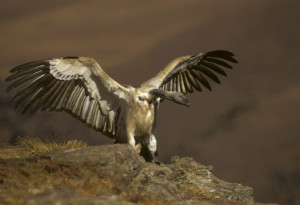LI NKED PAPER
NKED PAPER
The decline and rise of the Kransberg Cape Vulture colony over 35 years has implications for composite population indices and survey frequency. Benson, P.,C. & McClure, C.J.W. 2020. IBIS. DOI: 10.1111/ibi.12782 VIEW
African vulture populations are declining due to a variety of threats, including poisoning and trade in traditional medicines. A recent assessment of eight species reported an average population decline of 62 percent over the last 30 years (Ogada et al. 2016). Six species could even be considered Critically Endangered. To document these long-term population declines, the researchers combined data from several monitoring studies that used different techniques, such aerial surveys and counting breeding pairs. The results from these studies were converted into a percentage of change per year and subsequently summarized as a composite index of population change for each species. This approach illustrated the benefits of combining different datasets to document long-term population dynamics. However, it is not always possible to construct such continuous long-term datasets. How many years of monitoring can you miss without losing valuable information? A recent study on Cape Vultures (Gyps coprotheres) provides some important insights into this issue.
Livestock
Patrick Benson and Christopher McClure analyzed a long-term dataset of Cape Vultures at the Kransberg colony in the Limpopo Province of South Africa. Between 1983 and 2003, the population declined from 916 to 579 breeding pairs. From 2003 onwards, however, the number of vultures increased by about 2.65 percent per year to 849 pairs in 2017. The reason behind the turning point in 2003 is not entirely clear, but it might be related to a change in livestock management in the area (Benson et al. 2004). An increase in the local human population led to more livestock and the degradation of communal lands. The combination of more cattle and less food to sustain them resulted in higher mortality rates among livestock, providing Cape Vultures with an abundant buffet.
Figure 1 Population dynamics of Cape Vultures at the Kransberg colony in the Limpopo Province of South Africa between 1983 and 2017. The dark line show the number of active pairs and the light line the number of fledglings. Notice the turning point in 2003.
Power analysis
Next, the researchers performed a “retrospective power analysis” in which they removed certain years from the dataset and re-estimated population dynamics. This exercise revealed that if they skipped more than two years between surveys, they were not able to detect the population increase after 2003. From a more positive perspective, however, this also means that using data from every third year still provided reliable estimates of population size changes. If we focus on the Cape Vultures, the answer to our initial question – How many years of monitoring can you miss without losing valuable information? – is straightforward: surveys every two or three years are sufficient to capture general population trends. Unfortunately, this conclusion cannot be generalized to monitor all bird species. The design of a specific monitoring project should take into account the expected magnitude of population trends, the length of the study, and the cost (Wiens 1984). But it is hopeful that incomplete datasets and composite indices (Buckland et al. 2005) have the power to reliably estimate population dynamics, especially in the ongoing biodiversity crisis (Ceballos et al. 2020).
References
Benson, P. C., Plug, I., & Dobbs, J. C. (2004). An analysis of bones and other materials collected by Cape Vultures at the Kransberg and Blouberg colonies, Limpopo Province, South Africa. Ostrich 75: 118-132. VIEW
Buckland, S. T., Magurran, A. E., Green, R. E., & Fewster, R. M. (2005). Monitoring change in biodiversity through composite indices. Philosophical Transactions of the Royal Society B 360: 243-254. VIEW
Ceballos, G., Ehrlich, P. R., & Raven, P. H. (2020). Vertebrates on the brink as indicators of biological annihilation and the sixth mass extinction. Proceedings of the National Academy of Sciences 117: 13596-13602 VIEW
Ogada, D., Shaw, P., Beyers, R. L., Buij, R., Murn, C., Thiollay, J. M. et al. (2016). Another continental vulture crisis: Africa’s vultures collapsing toward extinction. Conservation Letters 9: 89-97. VIEW
Wiens, J. A. (1984). The place of long-term studies in ornithology. The Auk 101: 202-203. VIEW
Image credits
Top right: Cape Vulture Gyps coprotheres | Francesco Veronesi | CC BY-SA 2.0 Wikimedia Commons






